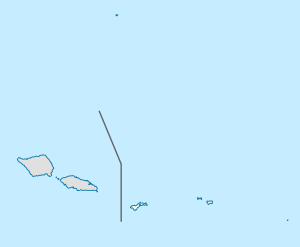ʻAoa | |
|---|---|
Village | |
| Coordinates: 14°15′56″S 170°35′2″W / 14.26556°S 170.58389°W | |
| Country | |
| Territory | |
| Area | |
| • Total | 0.66 sq mi (1.72 km2) |
| Elevation | 3 ft (1 m) |
| Population (2010) | |
| • Total | 855 |
| • Density | 1,300/sq mi (500/km2) |
| Time zone | UTC−11 (Samoa Time Zone) |
| ZIP code | 96799 |
| Area code | +1 684 |
ʻAoa is a village on the north-east coast of Tutuila Island, American Samoa.[1] It is located on the north coast, close to the island's eastern tip, at a narrowing of the island and is connected by road with Amouli on the south coast. ʻAoa is the oldest site on Tutuila to yield ceramics. Located in a large U-shaped valley on the northeast coast of the island, ʻAoa sits on a wide, sandy beach fronted by a large, deep bay. Fresh water is supplied by a steady river which runs through the village.[2] It is located in Vaifanua County.[3]
Over 40 ancient star mounds have been discovered in the bush near ʻAoa. Village chiefs believe these elevated stone platforms were used in the ancient chiefly sport of pigeon-snaring. Archeologists believe they served as military lookouts due to their placement at strategic vantage points, perhaps as a military lookout for enemy canoes. Besides the star mounds, lepita pottery has been discovered in ʻAoa. Some estimates date some of the potshards discovered here to 2000 BCE, while most of the scientific community dates them to 500 BCE. The Department of Tourism operated a camp site here complete with showers and barbecue facilities. The campsite was however closed as of 1994.[4]
It is one of few places in American Samoa with remaining patches of mangrove forest. The largest such forests are found in Nuʻuuli and Leone.
ʻAoa is adjacent to Faʻalefu, a neighboring village which shares ʻAoa Bay.
History[edit]
In 1942, Austrian immigrant to the U.S., Karl Paul Lippe, was billeted in the village of ʻAoa. He had joined the U.S. Marine Corps and was sent to the Samoan Islands. In the village of ʻAoa, Lippe was embraced by High Chief Logo, who asked him to move into his fale. Eventually, Lippe fell in love with Malele, the chief's daughter. At the time the young Marine was called off to war, his wife was pregnant. After World War II, he made an attempt to visit American Samoa, but was told no one was allowed to settle in the islands without the Naval Governor's permission. His request was initially denied but was later accepted when he managed to get in contact with the Chief of Naval Operations in Washington.[5]
Geography[edit]
The steep and mountainous terrain of the northern coast separates the villages along this coast from Pago Pago and other Tutuila villages. A narrow and unpaved road (as of 1975) connects ʻAoa with its neighboring villages.[6]
Demographics[edit]
| Year | Population[7] |
|---|---|
| 2010 | 855 |
| 2000 | 507 |
| 1990 | 491 |
| 1980 | 304 |
| 1970 | 271 |
| 1960 | 202 |
| 1950 | 194 |
| 1940 | 141 |
| 1930 | 137 |
References[edit]
- ^ Shaffer, Robert J. (2000). American Samoa: 100 Years Under the United States Flag. Island Heritage. Page 210. ISBN 9780896103399.
- ^ Shaffer, Robert J. (2000). American Samoa: 100 Years Under the United States Flag. Island Heritage. Page 36. ISBN 9780896103399.
- ^ Krämer, Augustin (2000). The Samoa Islands. University of Hawaii Press. Page 424. ISBN 9780824822194.
- ^ Swaney, Deanna (1994). Samoa: Western & American Samoa: a Lonely Planet Travel Survival Kit. Lonely Planet Publications. Page 178. ISBN 9780864422255.
- ^ Kennedy, Joseph (2009). The Tropical Frontier: America's South Sea Colony. University of Hawaii Press. Page 214. ISBN 9780980033151.
- ^ United States. Army. Corps of Engineers. Pacific Ocean Division (1975). Water Resources Development by the U.S. Army Corps of Engineers in American Samoa, 1975. Division Engineer, U.S. Army Engineer Division, Pacific Ocean, Corps of Engineers. Page 36.
- ^ "American Samoa Statistical Yearbook 2016" (PDF). American Samoa Department of Commerce. Archived from the original (PDF) on 2019-02-14. Retrieved 2019-07-25.
